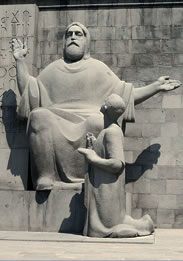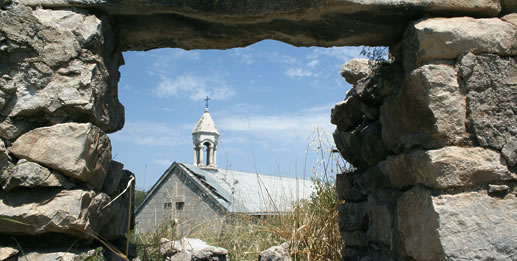St. Gregory and St. Grigoris
Nagorno Karabakh’s Amaras Monastery was established in the 4th century by St. Gregory the Enlightener, also known as St. Gregory the Illuminator or St. Gregory the Armenian—the apostle, national saint, and patron of Armenia who turned his country into the world’s first Christian state in 301 AD. St. Gregory is venerated not only by the Armenian Apostolic Church but also by Roman Catholics and Eastern Orthodox Christians.
St. Grigoris was St. Gregory’s grandson. In 340 AD, he was ordained as bishop of the Eastern Lands of Armenia, which included Artsakh (present-day Nagorno Karabakh). St. Grigoris preached the Holy Gospel among the mountaineers of the Northern Caucasus and martyred on the territory of modern Dagestan (ethnic autonomy in the Russian Federation) in 348 AD. His body was brought back to Artsakh and buried at the Amaras Monastery.
Christianity was introduced into Armenia shortly after the martyrdom of Jesus Christ, by two of his apostles—St. Thaddeus and St. Bartholomew. Armenians, however, knew about and even corresponded with Christ at the very time when Jesus was gaining fame as a miracle-worker and the Holy Land’s unusual preacher. Abgar, son of Arsham, who is mentioned by Movses Khorenatsi as King of Armenia, exchanged letters with Christ, asking him to visit him in the city of Edessa and heal him of leprosy. Jesus declined, but in a letter, written by St. Thomas, he promised to send a messenger endowed with divine powers, namely Thaddeus—one of the seventy apostles. St. Thaddeus arrived in Edessa and cured King Abgar after the Ascension of Christ, in 44 AD.
The story of King Abgar, the biography of St. Gregory the Enlightener and the process of conversion of Armenia into Christianity are described in details by several early medieval Armenian historians and chroniclers, such as Agatangeghos and Pavstos Buzand. [1] This also was done by Armenia’s most significant historian of that time Movses Khorenatsi, in his History of Armenia (Պատմություն Հայոց). [2] Khorenatsi was a pupil of the inventor of Armenian alphabet Mesrob Mashtots, and lived between 410 AD and 490 AD.
In Armenian historical texts St. Gregory was described as an orphan in the city of Caesarea—in Asia Minor’s province of Cappadocia—who was born of Parthian parents in the third century. He received a Greek name, Gregory, from his nurse, a devout Christian. St. Gregory married a Christian lady named Mariam, and had two children, Vrtanes and Aristakes.
The story of St. Gregory’s mission in Armenia begins at the time when King Trdat III Arshakuni, King of Armenia (Tiridates III Arsakid in Greco-Roman transcription, reigned from 287-c. 330) was returning home from Rome to reclaim the throne of his ancestors. Trdat was a hero of Rome’s victorious war over the Goths, and enjoyed full backing of the empire. Movses Khorenatsi admires and exalts Trdat for his courage, statesmanship and his devotion to the Kingdom of Armenia.
The young and well-educated Gregory joined Trdat’s aldermen as a secretary. Being well aware about persecution of Christians in lands allied with Rome, Gregory decided to hide his background and his faith. But during a festival on the occasion of Trdat’s glorious comeback, Gregory was ordered to lay wreaths before the statue of the goddess Anahit, an important Armenian pagan deity. He refused and had to confess that he was a Christian.
Trdat was outraged to discover a hidden Christian in his ranks, and gave orders to punish Gregory for perceived disloyalty and to make him renounce his faith. St. Gregory’s passion, described in detail by the fifth century author Agathangeghos, and perhaps presented with exaggerations, reminds us how enduring one becomes through faith and prayer. Enraged by Gregory’s boldness, King Trdat ordered him to be subjected to twelve different kinds of torture. His head was placed in a carpenter’s vice and a mixture of salt, borax and rough vinegar was poured into his nose through a reed tube. When the king expressed amazement about his endurance, Gregory replied that it was due to the grace of God. Enraged at the answer, Trdat ordered his servants to pour melted lead over Gregory’s entire body, so that his flesh was completely burned. He miraculously survived this torture as well.
At the order of the king, Gregory was bound hand, foot and neck and incarcerated in a dungeon near the city of Karin—present-day Erzerum (now in Turkey). From that dungeon, Gregory was transferred to the city of Artashat and thrown into a bottomless pit reserved for notorious criminals.
But through divine intervention, Gregory survived this terrible ordeal for thirteen long years. He was secretly fed by a widow who tossed a loaf of bread into the pit each day. The pit later became known as Khor Virab (Խոր Վիրաբ, translated from Armenian as deep well). This site later became a major shrine around which the Khor Virab Monastery was built. The monastery is located 30 kilometers from Armenia’s capital city of Yerevan.
Gregory’s incarceration was followed by a country-wide campaign of persecution of Christians. The most infamous episode of that manhunt included the martyrdom of the Holy Virgins—a group of 32 young Christian women from Rome found refuge in Armenia’s capital city of Vagharshapat, fleeing from the Roman emperor Diocletian. Among them was Hripsimeh—a beautiful maiden of royal Roman lineage—whom King Trdat fell in love with. When Hripsimeh rejected Trdat’s advances, the King ordered to execute all 32 women, including their leader, abbess Gaianeh. The slaughter of the Virgins and other excesses of anti-Christian violence shattered Trdat’s sanity, and the mad King fell sick with what was described by Armenian historians as “pig’s disease.” In ancient manuscripts the king is often portrayed as having a pig’s head.
Trdat’s sister Khosrovidukht did everything to bring her brother back to sanity. One day in a dream she sees Gregory coming out of the dungeon and healing Trdat. The next day Gregory was taken from the pit and brought before the king. A long process of preaching and healing followed. Trdat III recovered and became a passionate Christian, and Gregory proceeded to baptize the Armenian royals in the River Euphrates. Trdat proclaimed Christianity as the state religion of Armenia, in 301 AD, which made the country the first officially Christian kingdom in the world. This conversion predated the conventional date of Constantine the Great’s personal acceptance of Christianity on behalf of the Eastern Roman Empire.
After becoming Armenia’s archpriest, St. Gregory organized the hierarchy of the Armenian Church by ordaining a bishop for every major province in the country. Although there were many other bishops in Armenia long before St. Gregory, he became the first Katholicos of All Armenians. In 303 AD, St. Gregory founded the seat of the Armenian Apostolic Church at Echmiadzin—a place where he experienced a vision in which Jesus Christ descends from haven and brings forth a splendid church. St. Gregory governed the Armenian Church for roughly 25 years. He died shortly after the convention of the First Ecumenical Council of the Universal Church in the city of Nicaea.
St. Gregory the Enlightener’s Foundation of the Amaras Cathedral
The 7th century author Movses Kaghankatvatsi, historian of Armenia’s eastern lands, describes in his History of the Province of Aghvank St. Gregory’s journey to what is modern Nagorno Karabakh. [3] Movses writes that St. Gregory, after visiting Iveria (Georgia), arrived in Mius Haband—the central district of Armenia’s province of Artsakh. There, St. Gregory envisioned a church near the town of Amaras and organized its construction by appointing a crew of architects and stonemasons. Before establishing the church, St. Gregory meditated on a high hill that rises above the Amaras valley. This hill bears St. Gregory’s name, and is known in Nagorno Karabakh as the Enlightener’s Mountain (Լուսավորչի լեռ).
St. Grigoris and his Mission in Artsakh (Nagorno Karabakh) and the Northern Caucasus
After the death of St. Grigoris, the throne of Armenia’s archpriest passed to his elder son, St. Aristakes, and, after his death—to his younger brother, St. Vrtanes. St. Vrtanes had two twin sons—Hiusik and Grigoris, born in 322 AD. Grigoris was named after his famous grandfather—St. Gregory the Enlightener. He was anointed as bishop of Iveria (Georgia) and Aghvank (eastern lands of Armenia) by his uncle St. Aristakes when he was only 18 years old. Armenian authors Pavstos Buzand (5th century) and Movses Kaghankatvatsi (7th century) write that in his journey to Aghvank, St. Grigoris first visited Artsakh’s city of Tsri and founded there a small church. The ruins of Tsri are near the village of Tsor, in Nagorno Karabakh Republic’s southern district of Hadrut.
After his stay in Tsri, St. Grigoris began a difficult journey to the Land of Mazkuts, in what is now the Republic of Dagestan in Russia’s Northern Caucasus. Historians often identify Mazkuts as the Massagetae—a confederation of Scythian and Hunnic tribes who migrated to the Northern Caucasus in ancient times from the Central Asia and the Volga region in Russia.
There, traveling from one settlement to next, Grigoris preached the Holy Gospel. Grigoris was given warm reception, and the missioners succeeded to convert many Mazkutans into Christianity. Grigoris was also received by Sanesan, King of the Mazkuts—a dynast said to be related to Parthia’s and Armenia’s Arsakid kings.
The Armenian author Movses Kaghankatvatsi mentions that the apogee of Grigoris’ proselytism was the conversion of three of Sanesan’s sons. However, Grigoris’ mission did not last long. Mazkutans were known for their maraudering expeditions into neighboring lands, and Grigoris was accused of being a spy of the Armenian king, purportedly sent to make Mazkutans and Huns safe for Armenia by turning them into Armenia’s Christian allies. Grigoris was caught and put to a martyr’s death. He was tied to a wild horse that was let loose on the plain of Vatnean, near the shores of the Caspian Sea, writes Movses Kaghankatvatsi.
Grigoris’ disciples reclaimed his body and, after suffering many deprivations, brought it to back to Artsakh’s district of Mius Haband. There, they secretly buried Grigoris near the northern wall of the church at Amaras, together with the relics of St. Zachary and St. Pantaleon the Healer (St. Panteleimon).
The haste with which St. Grigoris was buried was explained by the invasion of Armenia’s eastern provinces by King Sanesan and his Hun allies. Sanesan set his eyes on Armenia as soon as he learned that his sons fled with St. Grigoris’ Christian missionaries. As testified by Pavstos Buzand and Movses Kaghankatvatsi, in the initial stage of the raid Sanesan’s army captured Artsakh and other east Armenian lands and managed to find the remote Katarovank Monastery in Artsakh’s south that was built on top of the Dizapait Mountain (2,700 meters high, presently in Nagorno Karabakh Republic’s District of Hadrout). There, his Christian children were hiding among the monastery’s 3,870 hermits and pilgrims. Sanesan ordered to capture and kill everyone at Katarovank, including his own sons.
Sanesan’s incursion was eventually met by a massive counter-attack of the joint military force of Armenia’s royal armies under the leadership of Sparapet (commander-in-chief) Vache Mamikonian, which destroyed the invaders “to the last man.” Thus was avenged the blood of St. Grigoris, writes Movses Kaghankatvatsi.
King Vachagan the Pious’ Quest For St. Gregory’s Tomb
Decades passed after St. Grigoris’ death but the exact location of his grave remained unknown. The relics of the saint were rediscovered only in 489 AD, by the efforts of the most celebrated monarch of Armenia’s eastern lands—Vachagan the Pious, King of Aghvank. Movses Kaghankatvatsi describes how it happened in chapters 20, 21, 22 an 23 of Book I of his History.
Kaghankatvatsi writes that when Vachagan arrived at Amaras, he found many tombs in the church’s graveyard and near the church’s walls, but could not possibly identify which one belonged to St. Grigoris. Saddened by this fact, the king sent royal orders to all quarters of his domain, asking the clergy to pray God in an effort to solicit divine guidance for the discovery of the resting place of the saint. A large clerical diet was assembled in the town of Diutakan (ruins in the Mardakert District of the Nagorno Karabakh Republic), where the king and the clergy meditated on the relics dispatched to Artsakh by Armenia’s archpriest—Katholicos Hovhannes Mandakuni (reigned from 478 AD-490 AD). During successive night vigils, King Vachagan and members of the diet had visions in which St. Grigoris descended from heavens and showed the location of his grave. After experiencing these visions, King Vachagan immediately organized a church procession, which, armed with ornamented crosses, gonfalons and church banners, headed south to Amaras.
To the joy of the King and his people the relics were discovered—indeed buried under the wall of the church. Movses Kaghankatvatsi mentions that King Vachagan the Pious removed the relics from the grave, rinsed St. Grigoris’ bones in sweet wine and ordered to finally complete the construction of the Amaras cathedral. [4]
The place of St. Grigoris’ martyrdom is considered a shrine in Dagestan. Near the formerly Armenian village of Niugdi (Molla-Halil)—at the location of the saint’s martyrdom—there is an early medieval Armenian chapel named after St. Grigoris. The village’s Armenian inhabitants migrated to Russia’s city of Kizlyar in 1796. The restoration of the chapel in 1879 and 1916 was financed by the Armenian community of Dagestan’s ancient city of Derbent. It is noteworthy that St. Grigoris is venerated in Dagestan as a saint not only by the Christian communities but also by the country’s much more numerous Muslim population.
[1] The Live of Saint Gregory: The Armenian, Greek, Arabic, and Syriac Versions of the History Attributed to Agathangelos, translated from Old Armenian by Robert W. Thomson, Caravan Books, 2010. The Epic Histories: Attributed to P’awstos Buzand. Columbia University Press, Department of Near Eastern Languages and Civilizations, 1989.
[2] Moses Khorenatsi. History of the Armenians, translated from Old Armenian by Robert W. Thomson. Harvard University Press, 1978. In the treatise Adversus Judaeos written in 197 AD by Tertullian, the author speaks of the nations who had adopted Christianity: “ … the Parthians, Lydians, Phrygians, Cappadocians, and the Armenians.”
[3] Movses Kalankatuatsi. History of the Province of Aluank, translated from Old Armenian by Sh. V. Smbatian. Yerevan: Matenadaran (Institute of Ancient Manuscripts), 1984, Book I, chapter 14, in Russian.
[4] Movses Kalankatuatsi. History of the Province of Aluank, translated from Old Armenian by Sh. V. Smbatian. Yerevan: Matenadaran (Institute of Ancient Manuscripts), 1984, Book I, chapter 23, page 54, in Russian.




